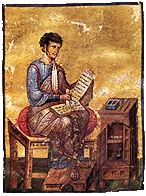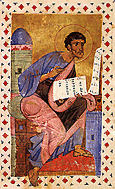 |
|
 |
Manuscripts
 ooks played a
very important role in the social life ooks played a
very important role in the social life
 of the Late Byzantine period and especially in the life of the upper class, whose members, as the byzantinologist H. Belting says, were veritable bibliomaniacs. For the members of the aristocracy, the building up of personal libraries was indispensable, since a good education was a prerequisite if they wished to rise to higher offices. Libraries were also a very important material asset, a fact that we can easily understand, if we consider that the copying and decoration of a book cost approximately 15-20 nomismata, an amount that corresponded to half the annual salary of a state employee.
of the Late Byzantine period and especially in the life of the upper class, whose members, as the byzantinologist H. Belting says, were veritable bibliomaniacs. For the members of the aristocracy, the building up of personal libraries was indispensable, since a good education was a prerequisite if they wished to rise to higher offices. Libraries were also a very important material asset, a fact that we can easily understand, if we consider that the copying and decoration of a book cost approximately 15-20 nomismata, an amount that corresponded to half the annual salary of a state employee.
The common practice in aristocratic circles of materially supporting the monastic institutions of the capital, included caring for their libraries. Thus, Theodore Metochites bequeathed his personal library to the Chora monastery, while Theodora Raoulaina Palaiologina retired to the important monastery of St Andrew in
 Krisei and concerned herself with the enrichment of its library. Fifteen manuscripts, which have been located in various libraries and are characterised by similarities both in their writing and in the style of their miniatures, are attributed to the workshop that, towards the end of the 13th century, produced works commissioned by the nun-princess. The miniatures decorating these manuscripts follow the style of painting prevailing at the time, especially that of icons, with which the paintings in the manuscript share the same micrographic character. Krisei and concerned herself with the enrichment of its library. Fifteen manuscripts, which have been located in various libraries and are characterised by similarities both in their writing and in the style of their miniatures, are attributed to the workshop that, towards the end of the 13th century, produced works commissioned by the nun-princess. The miniatures decorating these manuscripts follow the style of painting prevailing at the time, especially that of icons, with which the paintings in the manuscript share the same micrographic character.
Two more groups of manuscripts are worth mentioning at this point. The first is a series of manuscripts in which the text is written in both Greek and Latin. These works are addressed to a bilingual public, for which reason they are believed to be works produced by the workshops of the capital during the period of Latin rule (1204-1261).
The second interesting group is that known as the 'group of Nicaea'. The miniatures of this group are characterised by the absence of the classical spirit which is a feature of all the aforementioned manuscripts. Research carried out at a later date proved that they were works of provincial workshops of Palestine and Cyprus, dating from the mid 11th to mid 12th century, which gives us a picture of the intellectual and artistic activity in the Levant.
See also: Theodore Metochites
|